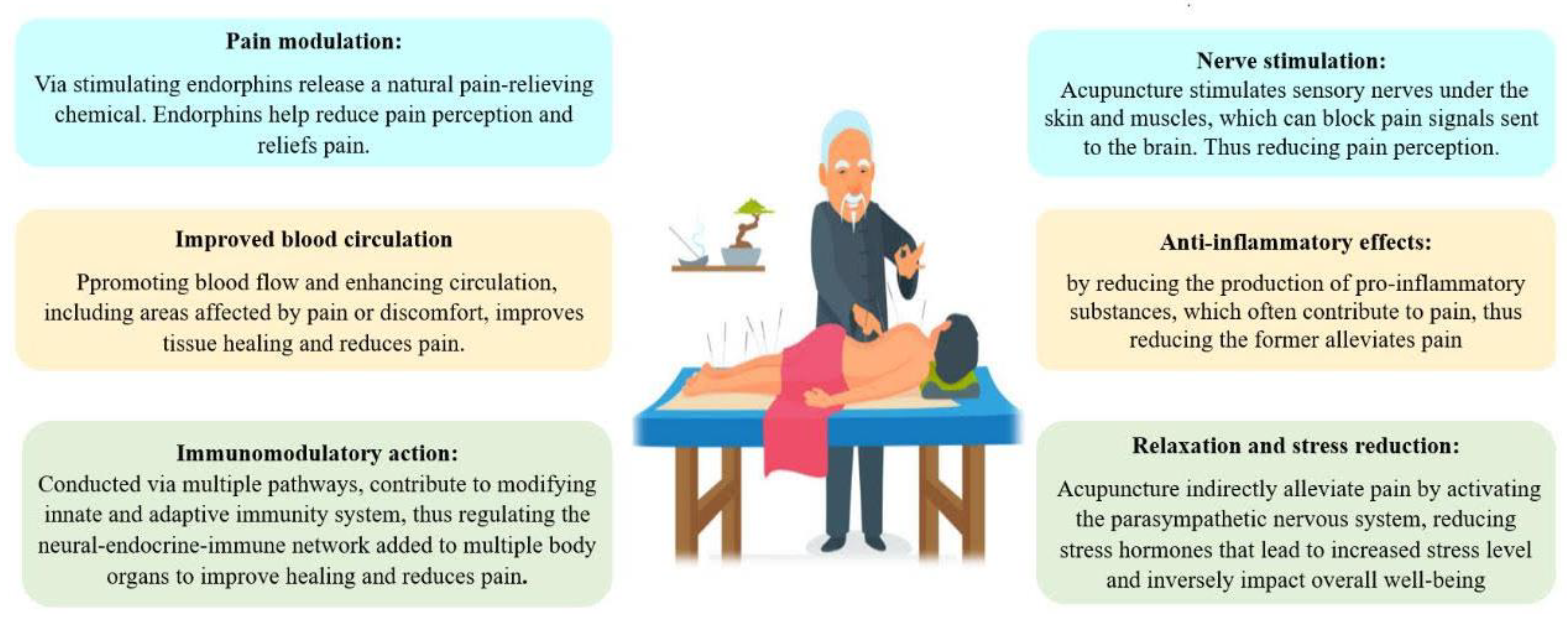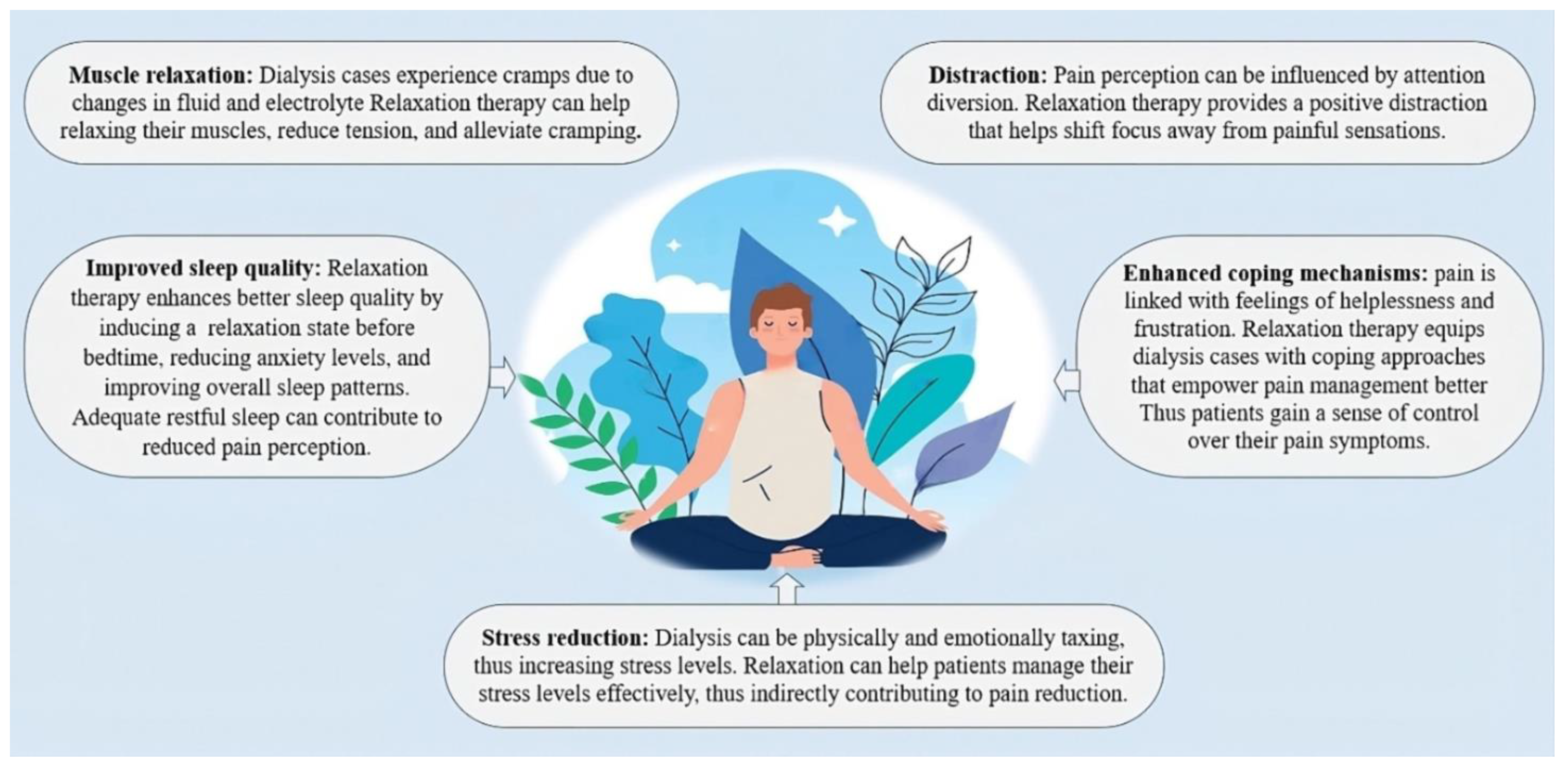Acupuncture demonstrated considerable promise as a benign and efficacious supplementary therapy for managing pain, enhancing functional capacity and muscular strength, lessening symptoms of restless leg syndrome and uremic pruritus, and bettering the quality of life (QOL) of patients on hemodialysis. Additional investigations are imperative to confirm these results and define the ideal parameters for treatment. Cognitive behavioral therapy also exhibited the potential to ameliorate diverse facets of wellness in hemodialysis patients, including social support, QOL, and mental health outcomes. Cognitive behavioral therapy (CBT) proved successful in attenuating depressive symptom severity, enhancing therapy adherence, and diminishing depression. Internet-based CBT could potentially enhance the accessibility and effectiveness of these interventions for this patient population. Relaxation techniques, encompassing progressive muscle relaxation, guided imagery, deep breathing exercises, and mindfulness meditation, appear to hold potential in managing pain, fatigue, stress, and sleep patterns, as well as in promoting well-being and QOL for hemodialysis patients. Emerging as an innovative immersive technology, virtual reality has demonstrated potential benefits in pain management for individuals undergoing hemodialysis.
- pain management
- hemodialysis
- acupuncture
- cognitive behavioral therapy
- relaxation techniques
- virtual reality
1. Introduction
2. Acupuncture

3. Cognitive Behavioral Therapy (CBT)
4. Relaxation Techniques

5. Virtual Reality
6. Other Alternative Methods
This entry is adapted from the peer-reviewed paper 10.3390/jcm12165390
References
- Davison, S.N. Pain in hemodialysis patients: Prevalence, cause, severity, and management. Am. J. Kidney Dis. 2003, 42, 1239–1247.
- Thurlow, J.S.; Joshi, M.; Yan, G.; Norris, K.C.; Agodoa, L.Y.; Yuan, C.M.; Nee, R. Global Epidemiology of End-Stage Kidney Disease and Disparities in Kidney Replacement Therapy. Am. J. Nephrol. 2021, 52, 98–107.
- Kafkia, T.; Chamney, M.; Drinkwater, A.; Pegoraro, M.; Sedgewick, J. Pain in Chronic Kidney Disease: Prevalence, Cause and Management. J. Ren. Care 2011, 37, 114–122.
- dos Santos, P.R.; Mendonça, C.R.; Noll, M.; Borges, C.C.; Alves, P.M.; Dias, N.T.; Romeiro, A.M.d.S.; Barbosa, M.A.; Porto, C.C. Pain in Hemodialysis Patients: Prevalence, Intensity, Location, and Functional Interference in Daily Activities. Healthcare 2021, 9, 1375.
- Davison, S.N.; Jhangri, G.S. Impact of Pain and Symptom Burden on the Health-Related Quality of Life of Hemodialysis Patients. J. Pain Symptom Manag. 2010, 39, 477–485.
- Upadhyay, C.; Cameron, K.; Murphy, L.; Battistella, M. Measuring pain in patients undergoing hemodialysis: A review of pain assessment tools. Clin. Kidney J. 2014, 7, 367–372.
- Wilkinson, J.; Faleiro, R. Acupuncture in pain management. Contin. Educ. Anaesth. Crit. Care Pain 2007, 7, 135–138.
- Dhond, R.P.; Yeh, C.; Park, K.; Kettner, N.; Napadow, V. Acupuncture modulates resting state connectivity in default and sensorimotor brain networks. Pain 2008, 136, 407–418.
- Liu, X.; Wang, X.; Ma, H.; Zhang, W. Mechanisms underlying acupuncture therapy in chronic kidney disease: A narrative overview of preclinical studies and clinical trials. Front. Nephrol. 2022, 2, 1006506.
- Wang, M.; Liu, W.; Ge, J.; Liu, S. The immunomodulatory mechanisms for acupuncture practice. Front. Immunol. 2023, 14, 1147718.
- Ma, Q. Somatotopic organization of autonomic reflexes by acupuncture. Curr. Opin. Neurobiol. 2022, 76, 102602.
- Kim, K.H.; Lee, M.S.; Kim, T.-H.; Kang, J.W.; Choi, T.-Y.; Lee, J.D. Acupuncture and related interventions for symptoms of chronic kidney disease. Cochrane Database Syst. Rev. 2016, 2016, CD009440.
- de Carvalho, M.C.; de Azevedo, J.N.; Azevedo, P.; Pires, C.; Laranjeira, M.; Machado, J.P. Effect of Acupuncture on Functional Capacity in Patients Undergoing Hemodialysis: A Patient-Assessor Blinded Randomized Controlled Trial. Healthcare 2022, 10, 1947.
- Bullen, A.; Awdishu, L.; Lester, W.; Moore, T.; Trzebinska, D. Effect of Acupuncture or Massage on Health-Related Quality of Life of Hemodialysis Patients. J. Altern. Complement. Med. 2018, 24, 1069–1075.
- de Carvalho, M.C.; de Azevedo, J.N.; Azevedo, P.; Pires, C.; Machado, J.P.; Laranjeira, M. Effectiveness of Acupuncture on Health-Related Quality of Life in Patients Receiving Maintenance Hemodialysis. Healthcare 2023, 11, 1355.
- Tsai, L.-H.; Chen, C.-M.; Lin, L.-M.; Tsai, C.-C.; Han, Y.; See, L.-C. Acupressure reduces the severity of restless legs syndrome in hemodialysis patients: A cluster-randomized crossover pilot study. Biomed. J. 2022, 45, 533–541.
- Zhang, L.; Li, Y.; Xiao, X.; Shi, Y.; Xu, D.; Li, N.; Deng, Y. Acupuncture for Uremic Pruritus: A Systematic Review and Meta-Analysis. J. Pain Symptom Manag. 2022, 65, e51–e62.
- Ince, L.P. Cognitive Therapy and the Emotional Disorders. Am. J. Psychother. 1977, 31, 633–634.
- Ehde, D.M.; Dillworth, T.M.; Turner, J.A. Cognitive-behavioral therapy for individuals with chronic pain: Efficacy, innovations, and directions for research. Am. Psychol. 2014, 69, 153–166.
- Zegarow, P.; Manczak, M.; Rysz, J.; Olszewski, R. The influence of cognitive-behavioral therapy on depression in dialysis patients—Meta-analysis. Arch. Med. Sci. 2020, 16, 1271–1278.
- Zheng, H.; Li, J.; Li, Y.; Zhao, L.; Wu, X.; Chen, J.; Li, X.; Huang, Y.; Chang, X.; Liu, M.; et al. Acupuncture for patients with mild hypertension: A randomized controlled trial. J. Clin. Hypertens. 2019, 21, 412–420.
- Valsaraj, B.P.; Bhat, S.M.; Prabhu, R.; Kamath, A. Follow-Up Study on the Effect of Cognitive Behaviour Therapy on Haemodialysis Adherence: A randomised controlled trial. Sultan Qaboos Univ. Med. J. 2021, 21, e58–e65.
- Principles and Practice of Stress Management, 3rd ed.; The Guilford Press: New York, NY, USA, 2007; Available online: https://psycnet.apa.org/record/2007-14796-000 (accessed on 1 May 2023).
- Whitehouse, W.; Orne, E.; Orne, M. Relaxation Techniques. In Encyclopedia of Stress, 2nd ed.; Elsevier: Amsterdam, The Netherlands, 2007; pp. 345–350.
- Gorji, M.A.H.; Ardebil, M.D.; Mahdavi, A.; Gorji, A.M.H.; Yazdani, J. Implementing benson′s relaxation training in hemodialysis patients: Changes in perceived stress, anxiety, and depression. N. Am. J. Med. Sci. 2013, 5, 536–540.
- Syam, N.M.; Desoky, G.M.; Ahmed, H.; Eldesoky, M. Effects of Progressive Muscle Relaxation Technique on Severity of Restless Legs Syndrome Among Patients on Maintenance Hemodialysis. Orig. Artic. Egypt. J. Health Care 2022, 13, 102–120.
- Beizaee, Y.; Rejeh, N.; Heravi-Karimooi, M.; Tadrisi, S.D.; Griffiths, P.; Vaismoradi, M. The effect of guided imagery on anxiety, depression and vital signs in patients on hemodialysis. Complement. Ther. Clin. Pr. 2018, 33, 184–190.
- Riva, G.; Wiederhold, B.K.; Mantovani, F. Neuroscience of Virtual Reality: From Virtual Exposure to Embodied Medicine. Cyberpsychol. Behav. Soc. Netw. 2019, 22, 82–96.
- Hoffman, H.G.; Chambers, G.T.; Meyer, W.J.; Arceneaux, L.L.; Russell, W.J.; Seibel, E.J.; Richards, T.L.; Sharar, S.R.; Patterson, D.R. Virtual Reality as an Adjunctive Non-pharmacologic Analgesic for Acute Burn Pain During Medical Procedures. Ann. Behav. Med. 2011, 41, 183–191.
- Maddox, T.; Fitzpatrick, T. Virtual Reality in Chronic Kidney Disease Education and Training. Nephrol. Nurs. J. 2022, 49, 329–381.
- Burrows, B.; Wilund, K.; Hernandez, R. Fully immersive virtual reality for hemodialysis patients: Is it safe? Blood Purif. 2020, 49, 250–251.
- Maynard, L.G.; de Menezes, D.L.; Lião, N.S.; de Jesus, E.M.; Andrade, N.L.S.; Santos, J.C.D.; Júnior, W.M.d.S.; Bastos, K.d.A.; Filho, J.A.S.B. Effects of Exercise Training Combined with Virtual Reality in Functionality and Health-Related Quality of Life of Patients on Hemodialysis. Games Health J. 2019, 8, 339–348.
- Hernandez, R.; Burrows, B.; Browning, M.H.; Solai, K.; Fast, D.; Litbarg, N.O.; Wilund, K.R.; Moskowitz, J.T. Mindfulness-based Virtual Reality Intervention in Hemodialysis Patients: A Pilot Study on End-user Perceptions and Safety. Kidney360 2021, 2, 435–444.
- Vance, C.G.T.; Dailey, D.L.; Chimenti, R.L.; Van Gorp, B.J.; Crofford, L.J.; Sluka, K.A. Using TENS for Pain Control: Update on the State of the Evidence. Medicina 2022, 58, 1332.
- Yang, L.Y.; Chen, H.M.; Su, Y.C.; Chin, C.C. The effect of transcutaneous electrical nerve stimulation on increasing salivary flow rate in hemodialysis patients. Oral Dis. 2019, 25, 133–141.
- Linnemann, A.; Kappert, M.B.; Fischer, S.; Doerr, J.M.; Strahler, J.; Nater, U.M. The effects of music listening on pain and stress in the daily life of patients with fibromyalgia syndrome. Front. Hum. Neurosci. 2015, 9, 434.
- Thakare, A.; Jallapally, A.; Agrawal, A.; Salkar, P. Music Therapy and Its Role in Pain Control. In Music in Health and Diseases; IntechOpen: Rijeka, Croatia, 2022.
- Ginsberg, J.P.; Raghunathan, K.; Bassi, G.; Ulloa, L. Review of Perioperative Music Medicine: Mechanisms of Pain and Stress Reduction Around Surgery. Front. Med. 2022, 9, 821022.
- Colebaugh, C.A.; Wilson, J.M.; Flowers, K.M.; Overstreet, D.; Wang, D.; Edwards, R.R.; Chai, P.R.; Schreiber, K.L. The Impact of Varied Music Applications on Pain Perception and Situational Pain Catastrophizing. J. Pain 2023, 24, 1181–1192.
- Chai, P.R.; Gale, J.Y.; Patton, M.E.; Schwartz, E.; Jambaulikar, G.D.; Taylor, S.W.; Edwards, R.R.; Boyer, E.W.; Schreiber, K.L. The Impact of Music on Nociceptive Processing. Pain Med. 2020, 21, 3047–3054.
- Farrar, A.J.; Farrar, F.C. Clinical Aromatherapy. Nurs. Clin. N. Am. 2020, 55, 489–504.
- Jankowska, M.; Rogalska, J.; Wyszkowska, J.; Stankiewicz, M. Molecular Targets for Components of Essential Oils in the Insect Nervous System—A Review. Molecules 2018, 23, 34.
- Fung, T.K.H.; Lau, B.W.M.; Ngai, S.P.C.; Tsang, H.W.H. Therapeutic Effect and Mechanisms of Essential Oils in Mood Disorders: Interaction between the Nervous and Respiratory Systems. Int. J. Mol. Sci. 2021, 22, 4844.
- Agarwal, P.; Sebghatollahi, Z.; Kamal, M.; Dhyani, A.; Shrivastava, A.; Singh, K.K.; Sinha, M.; Mahato, N.; Mishra, A.K.; Baek, K.-H. Citrus Essential Oils in Aromatherapy: Therapeutic Effects and Mechanisms. Antioxidants 2022, 11, 2374.
